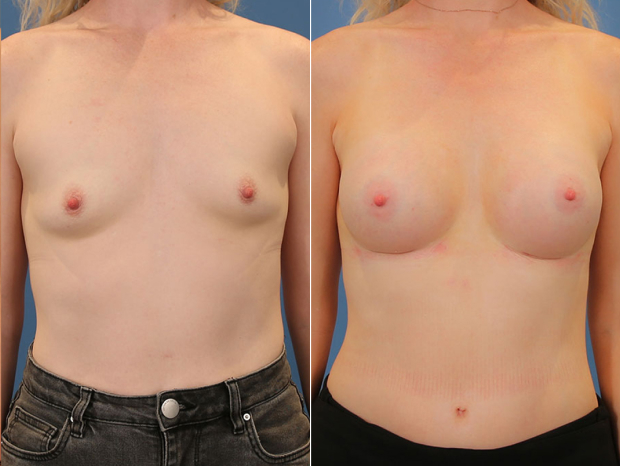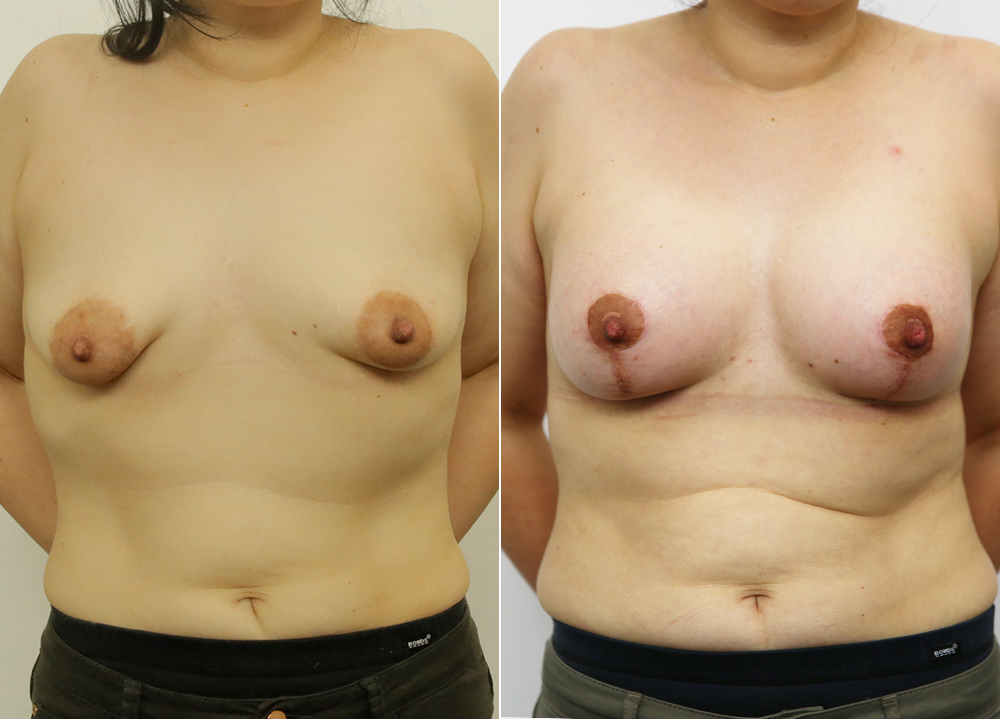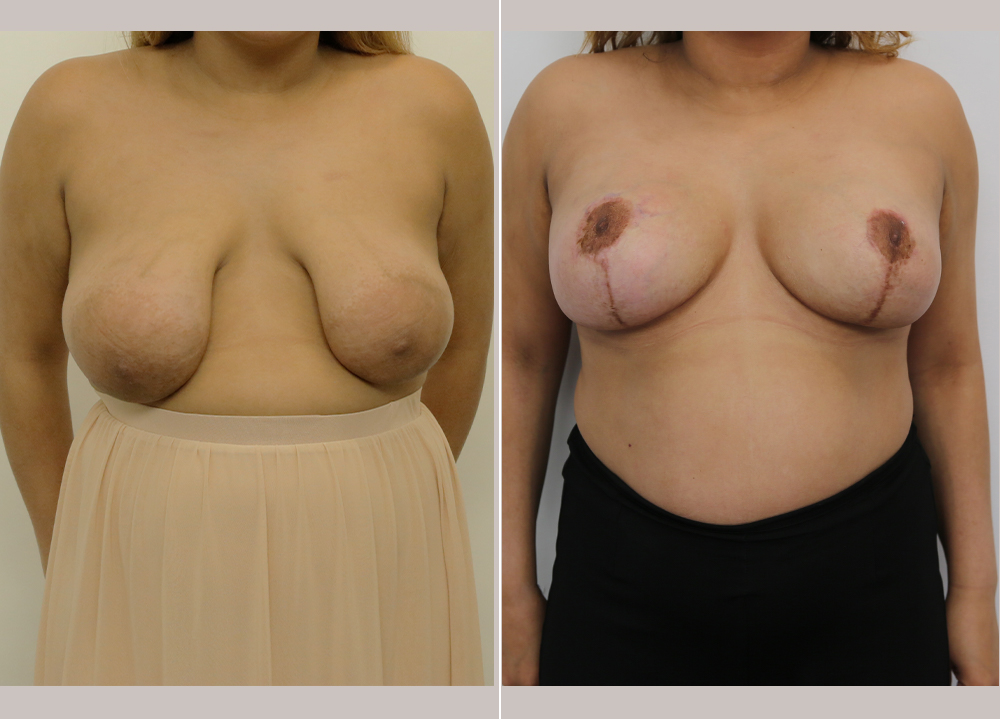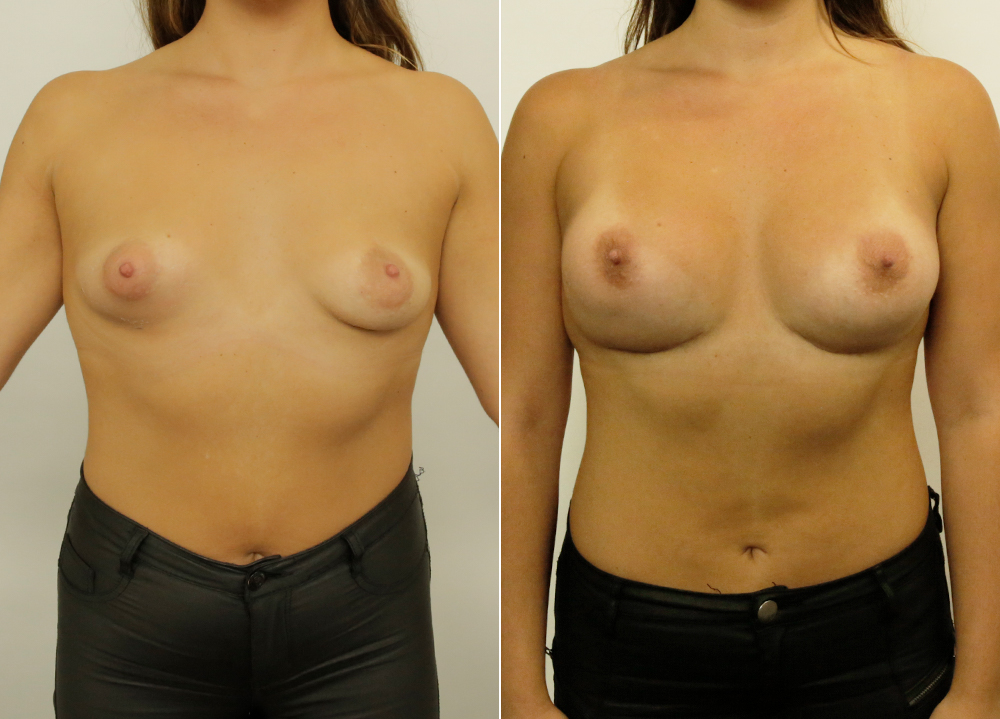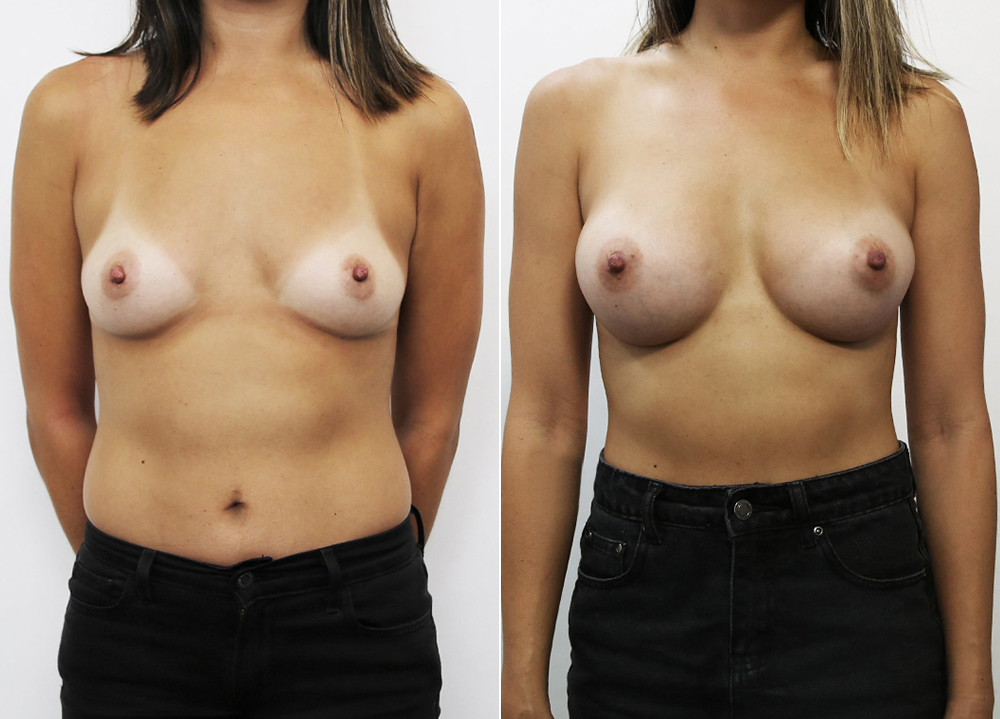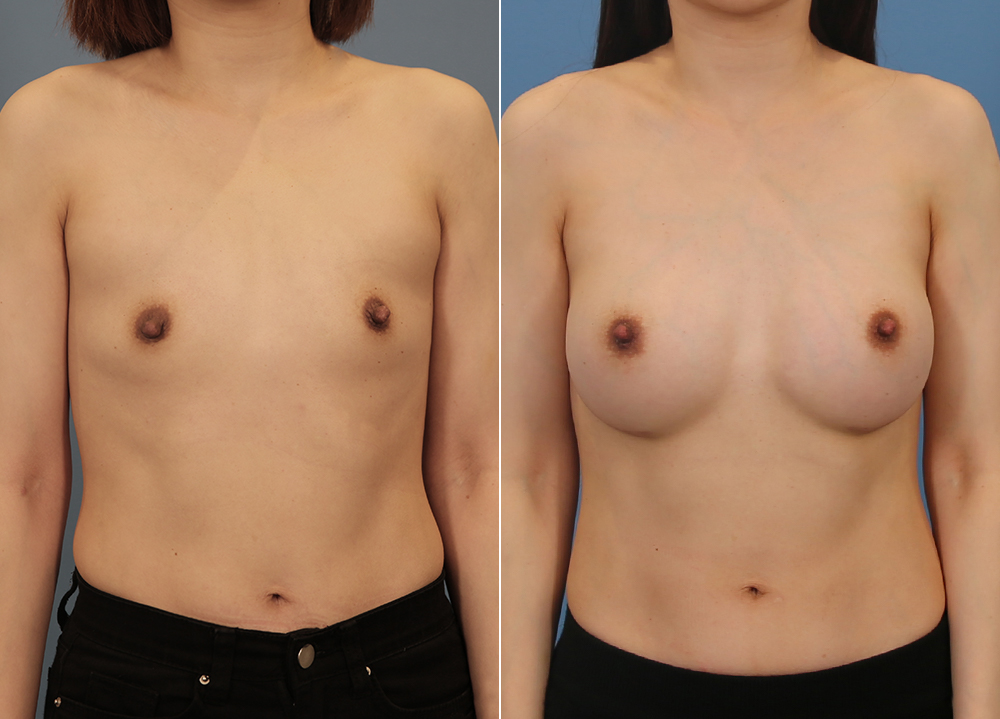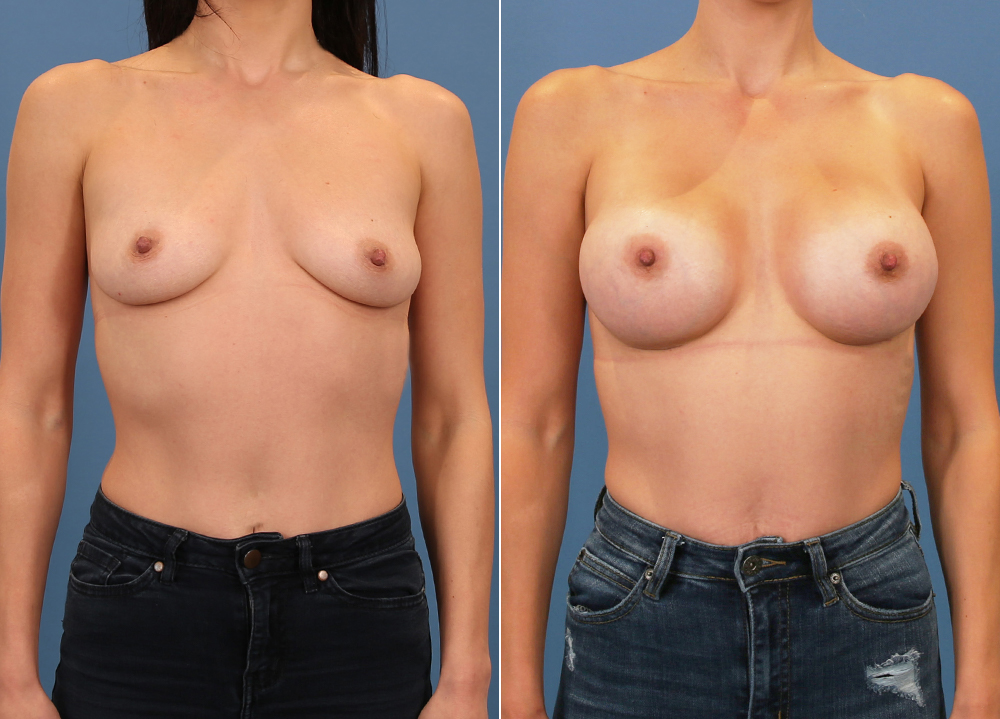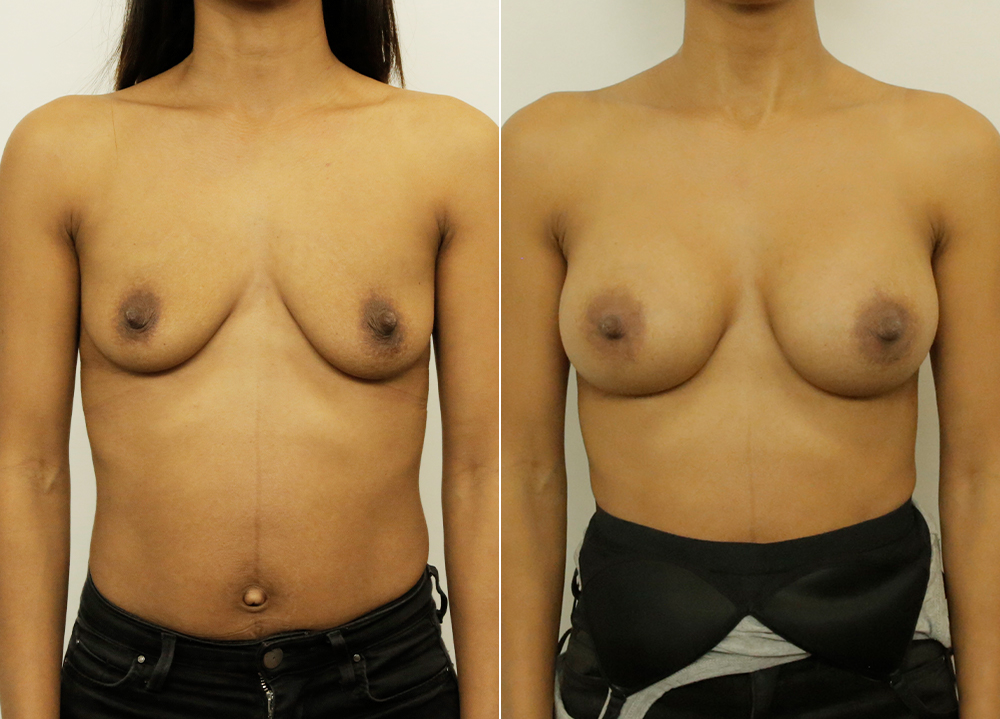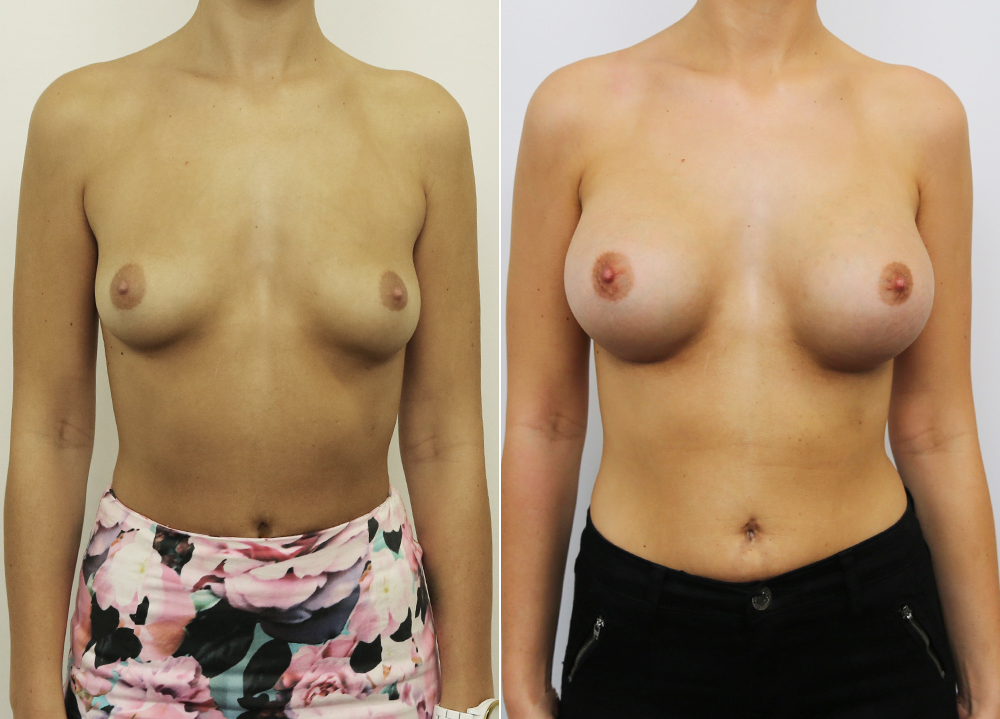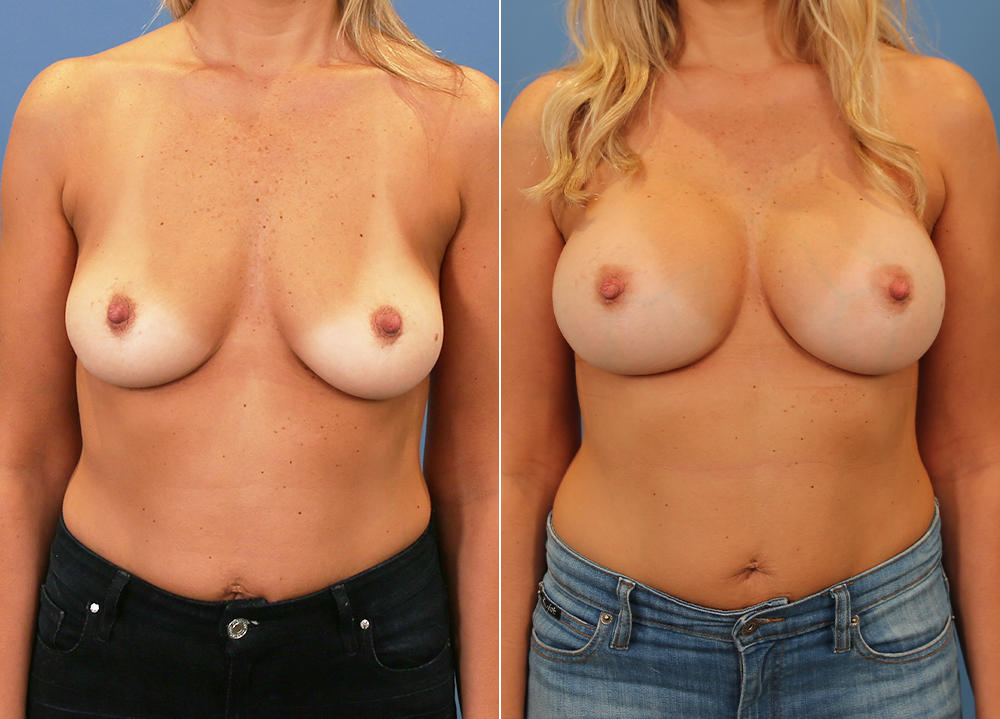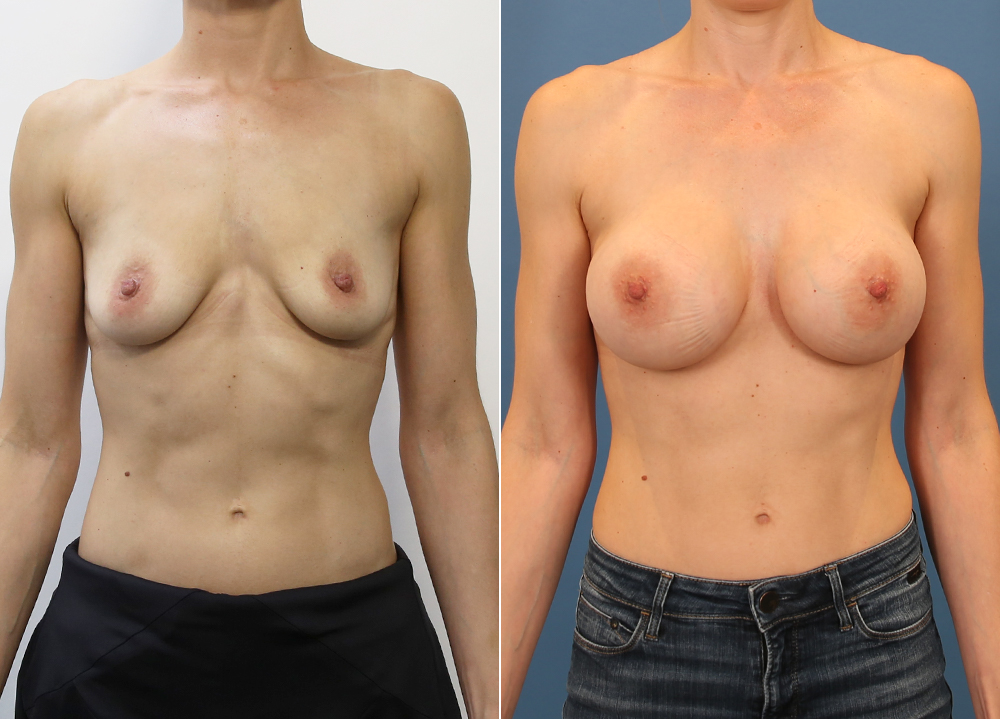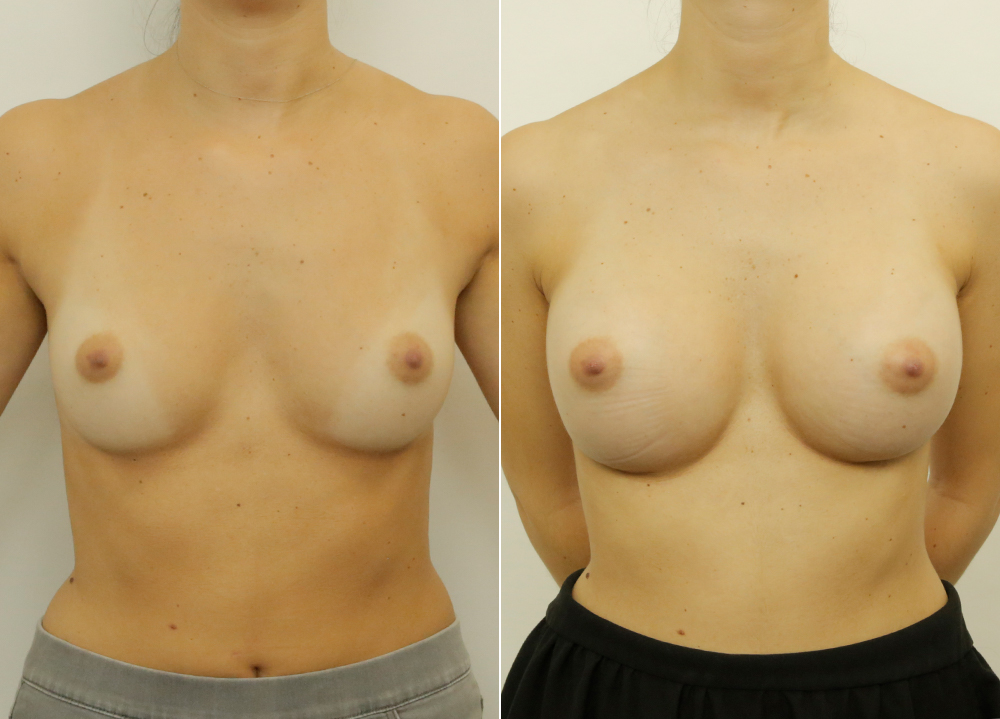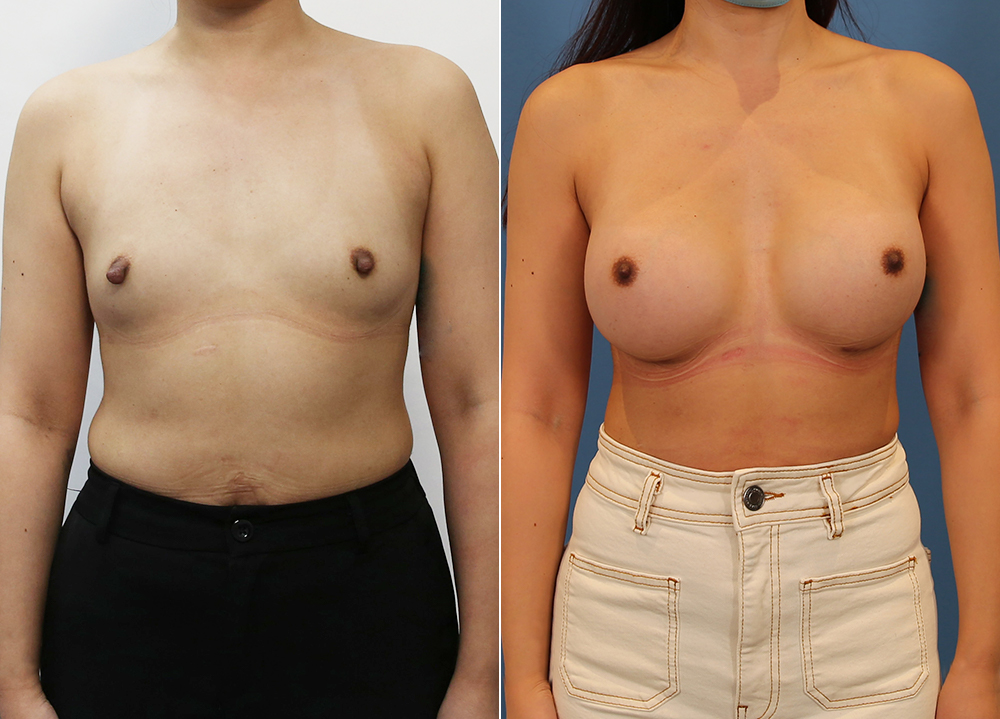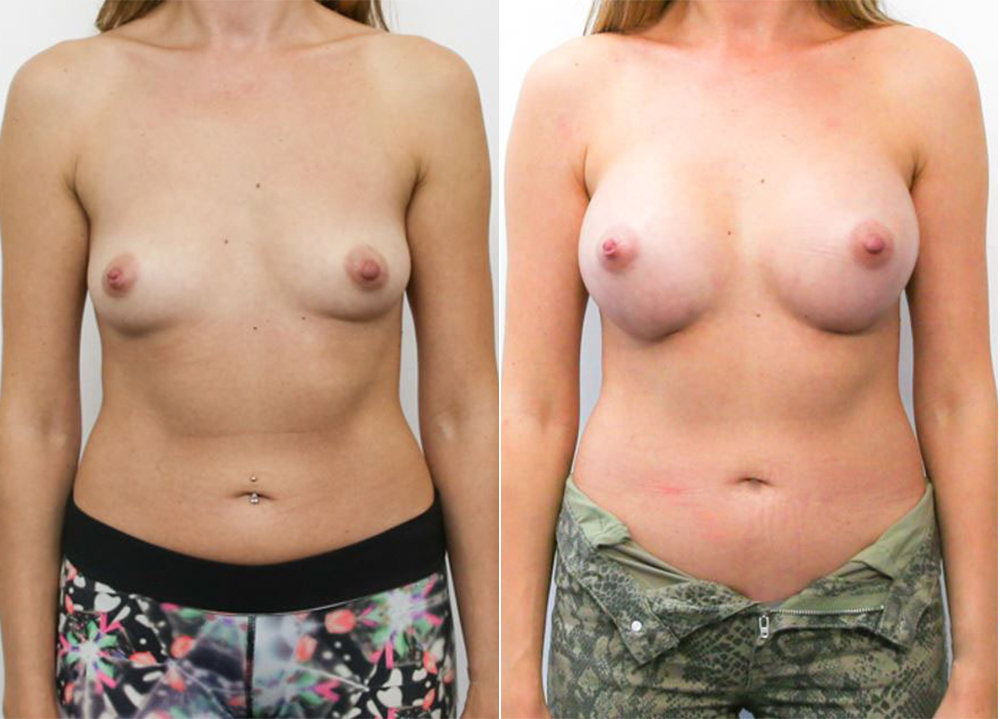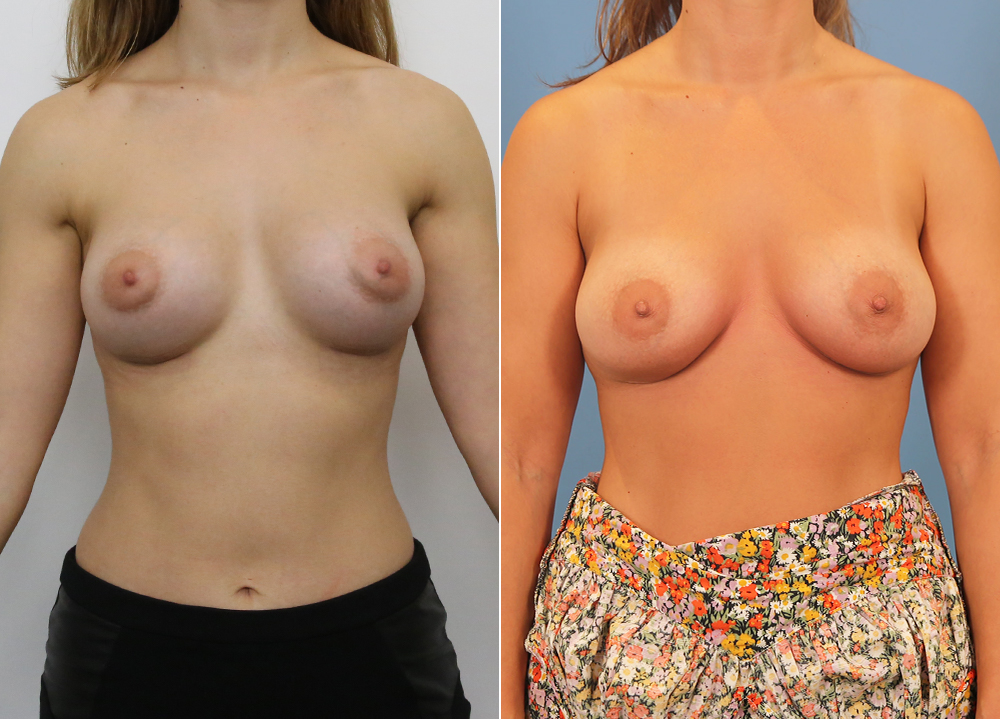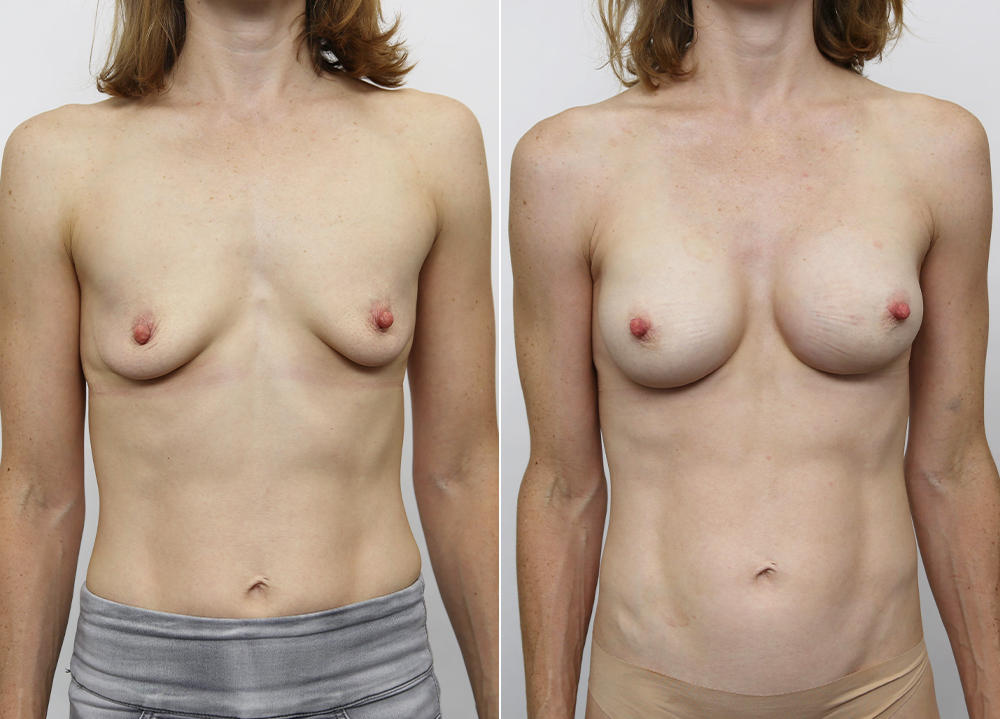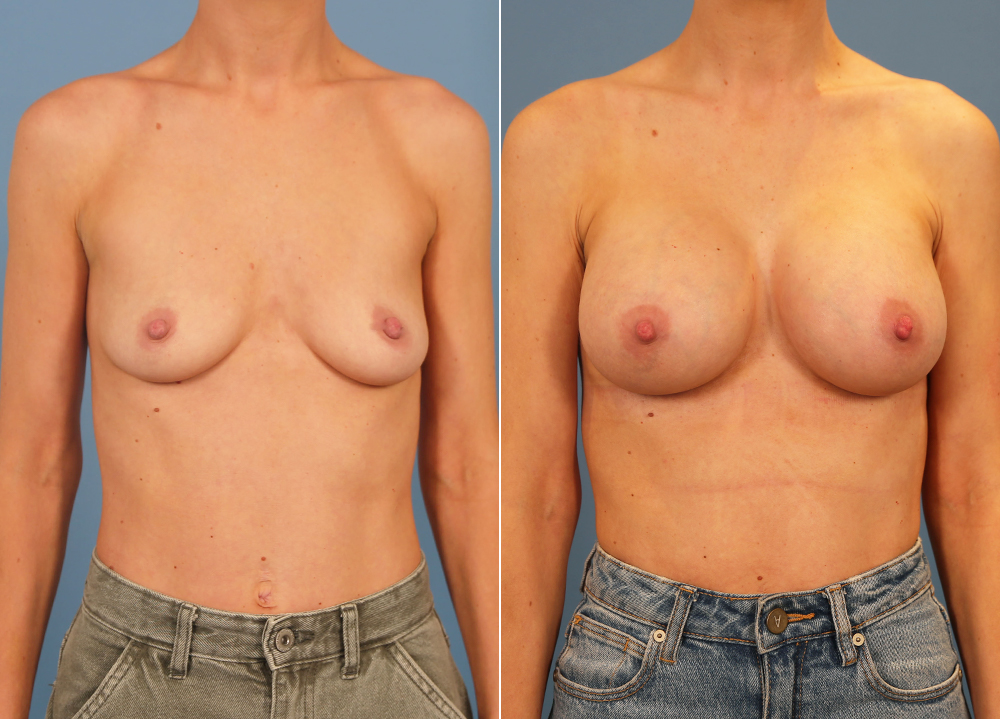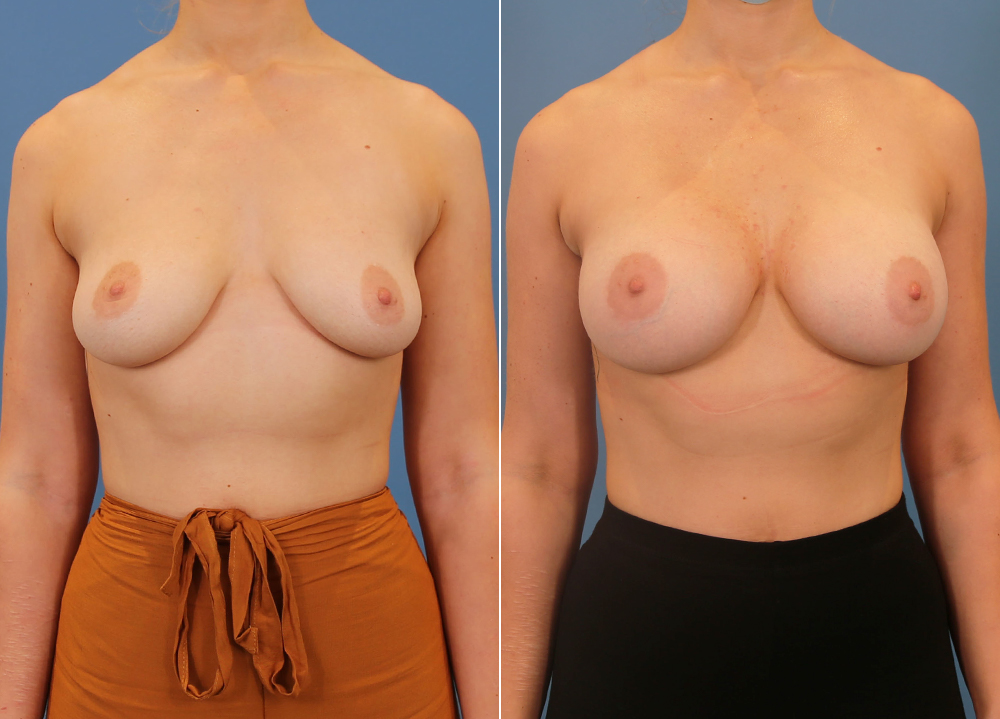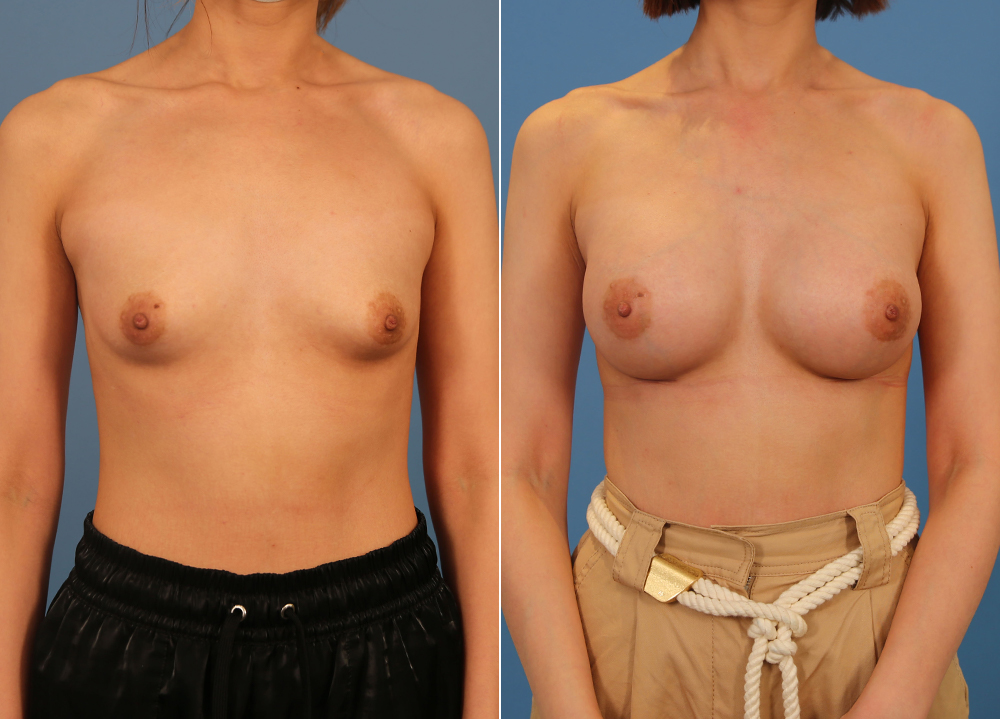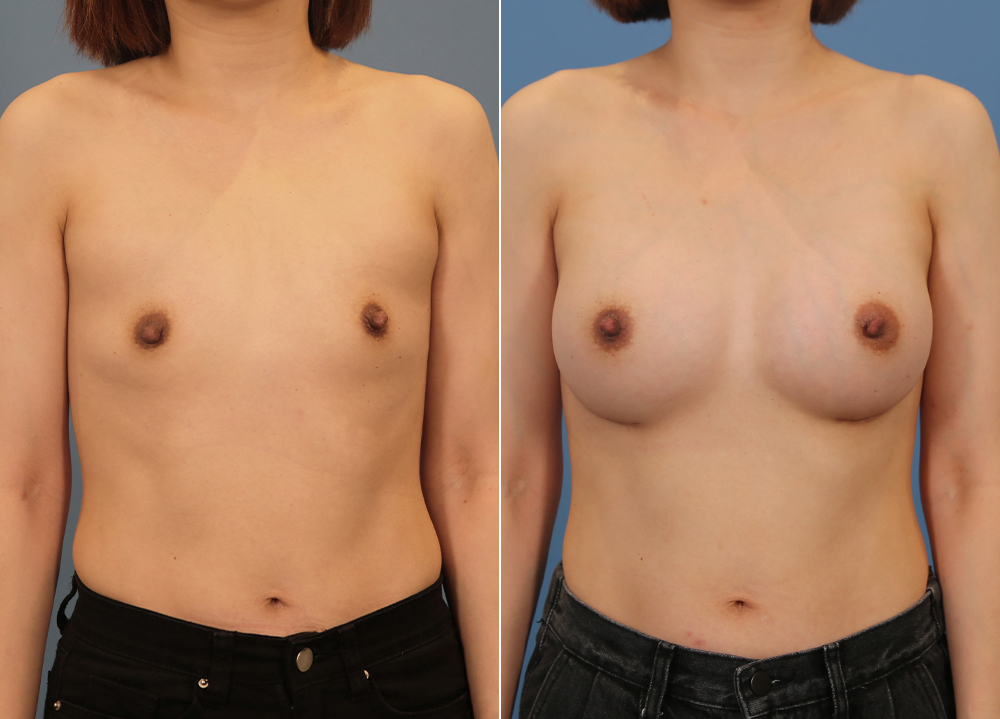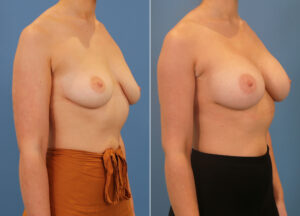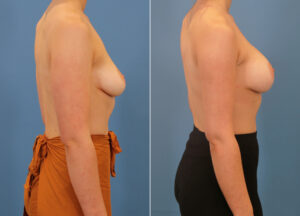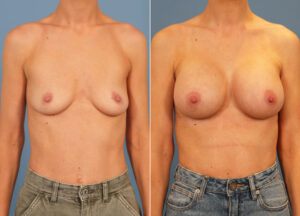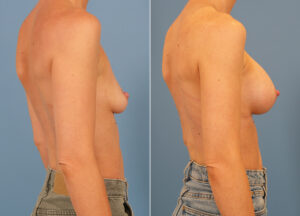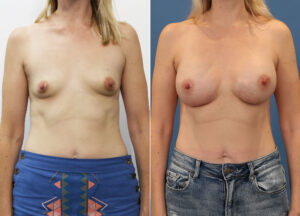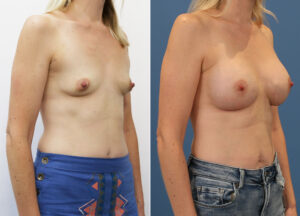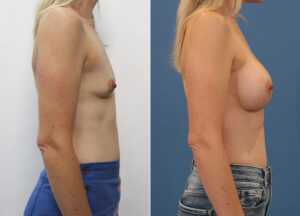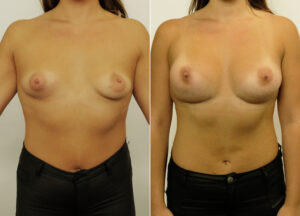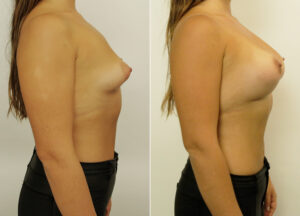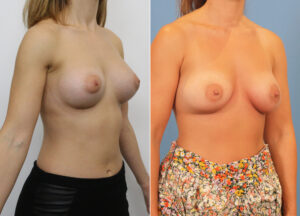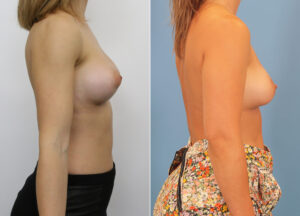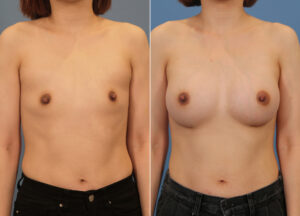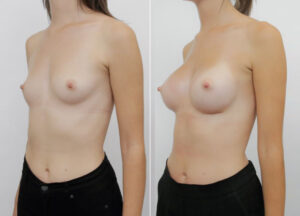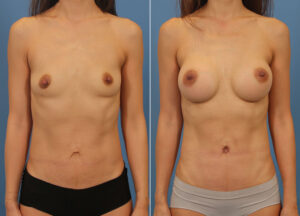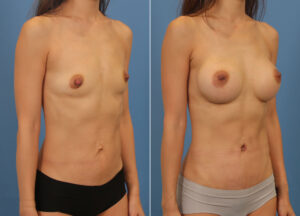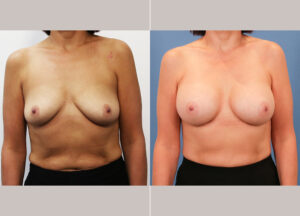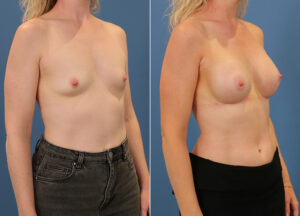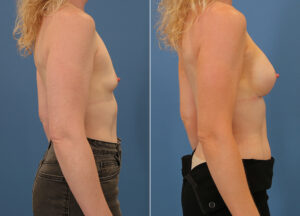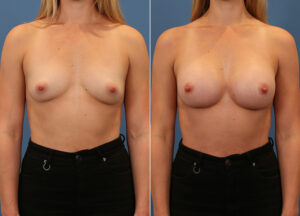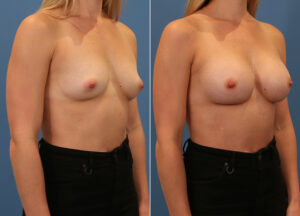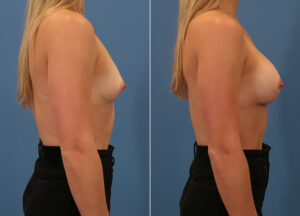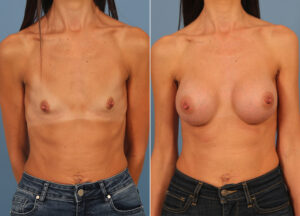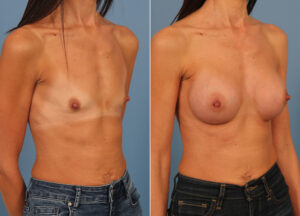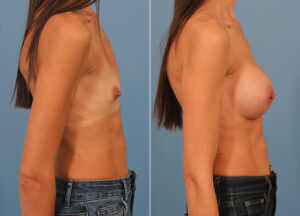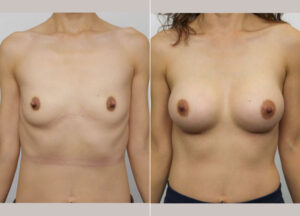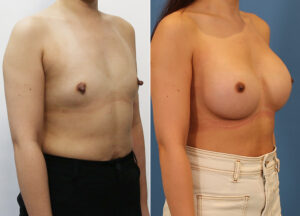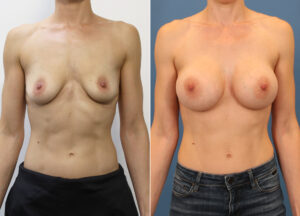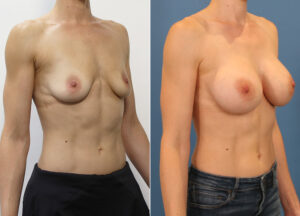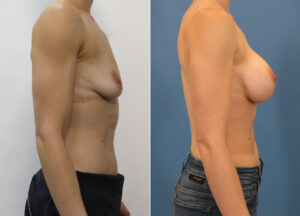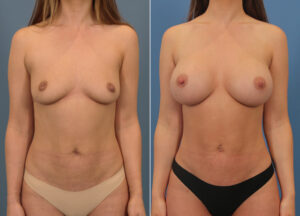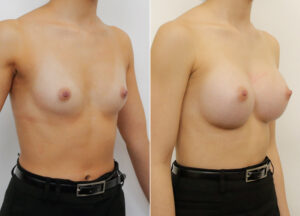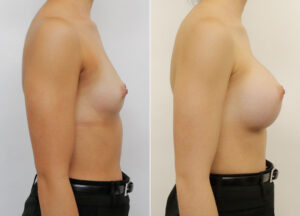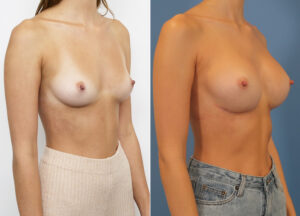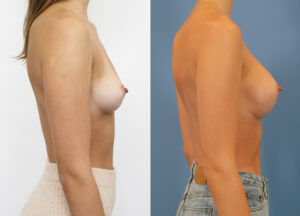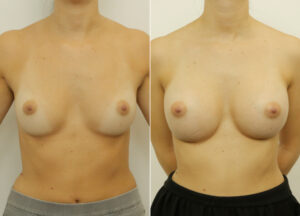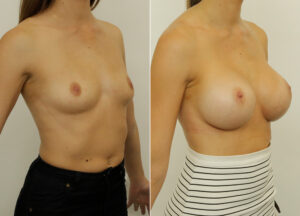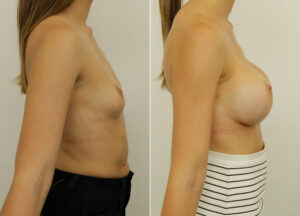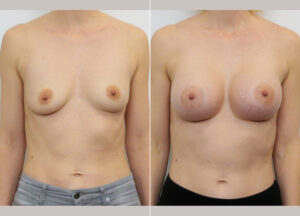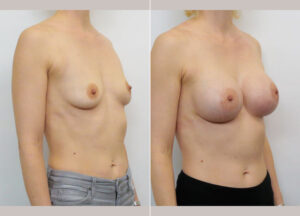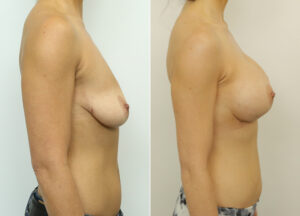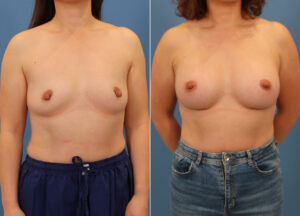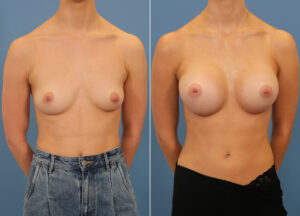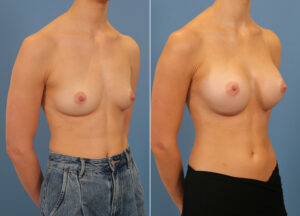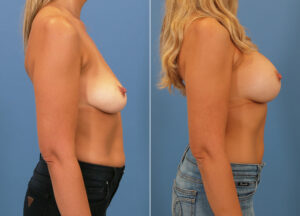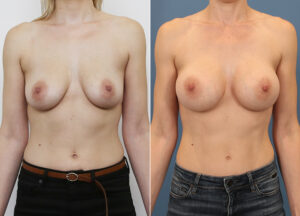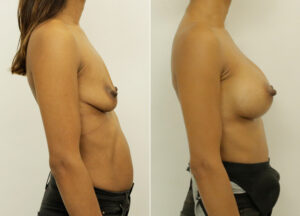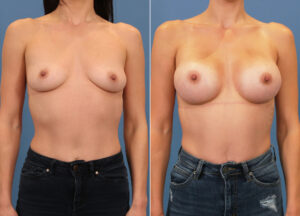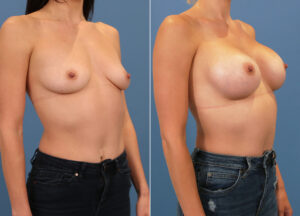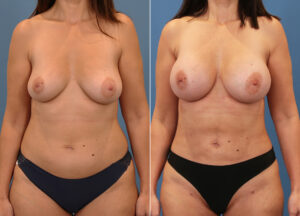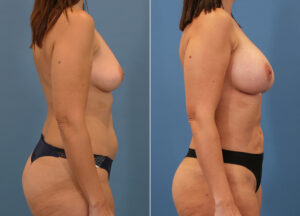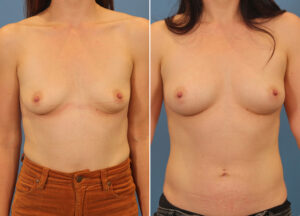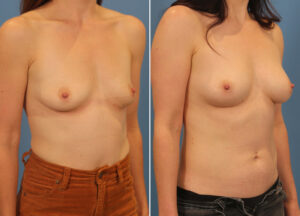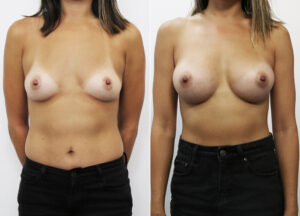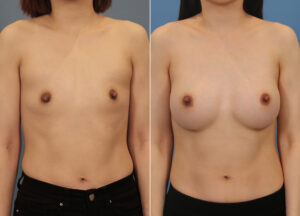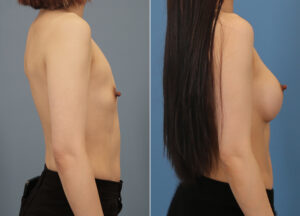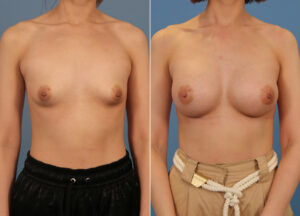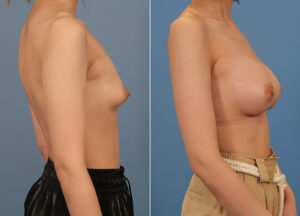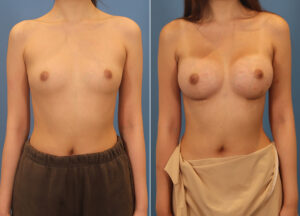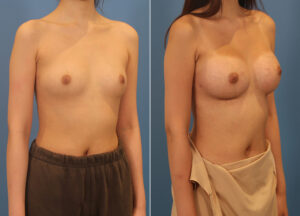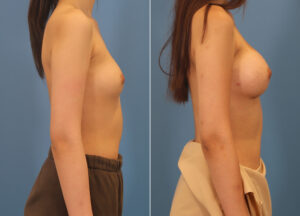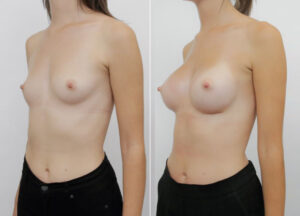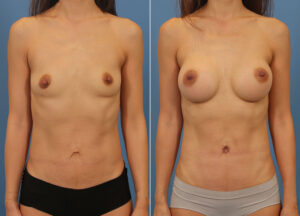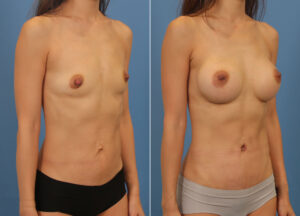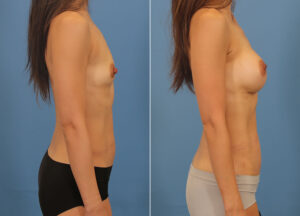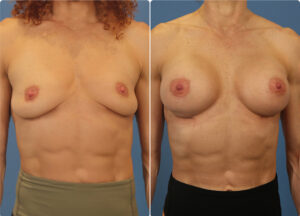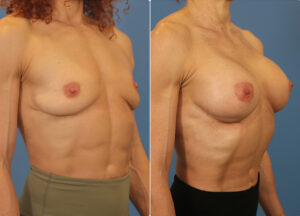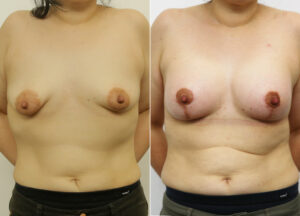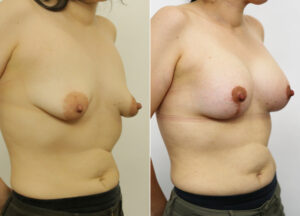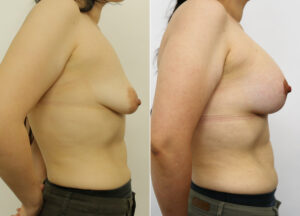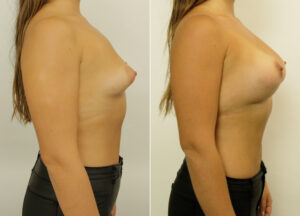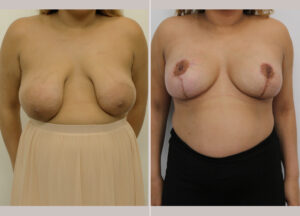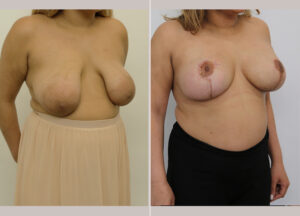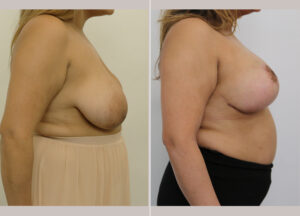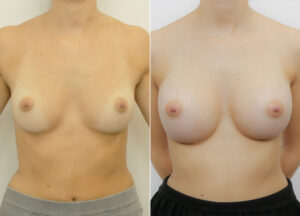


This patient had a hybrid breast augmentation (fat and an implant) as well as nipple reduction surgery
WHAT IS A BREAST AUGMENTATION?
A Breast augmentation involves implants being inserted beneath the breasts to enlarge them. The implant type and size depends on factors such as how much bigger you want your breasts to be, your breast anatomy, skin thickness and elasticity, and body type.
Breast augmentation is one of the most performed plastic surgical procedures. It is a safe and reliable operation that takes about an hour of surgical time, under a general anaesthetic and is considered a day surgery operation. It is sensible to take about a week off work after the surgery if you perform office-like activities and perhaps two weeks if you have an active job requiring lifting or moving of the shoulder. Most patients can be close to their final result at about 6-8 weeks after surgery, but the final result is usually achieved at about 6 months post surgery.




Why have your breast augmentation in Sydney with Dr Alex Phoon
Experience, attention to detail and excellent patient care form the basis of everything Dr Alex Phoon does. If you are looking for a surgeon to give you an amazing result whilst making you feel comfortable, confident and at ease during the process, look no further.
Most patients want to have the confidence that their surgeon has listened to what they want to achieve, and one that will develop a good plan to help achieve those goals. With Dr Alex Phoon, you can expect to have a more bespoke experience with a high level of care rather than being on the breast augmentation production line of ‘another breast augmentation patient’ who can always do it cheaper overseas- but what are you compromising on?
With Dr Alex Phoon you can expect excellent, individualised care with a highly skilled and experienced team of anaesthetists, nurses and patient coordinators. Dr Alex Phoon uses cutting edge implants and provides long term support to his patients in one of Australia’s finest plastic surgical clinics.
Due to NSW regulations, we are not permitted to share any testimonials on our website. However, patient feedback and reviews can easily be accessed through our Google Business Page as well as through trusted online resources such as Realself and Cosmetic Journey.
TYPES OF BREAST AUGMENTATION IN SYDNEY
Hybrid Breast Augmentation

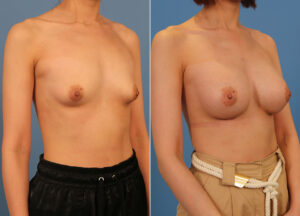
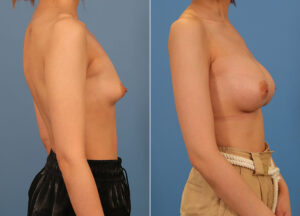
This patient desired a natural look and we were able to use Vectra 3D imaging to help her decide upon the perfect size for her goals. As you can see, the final result always looks better than the simulation but it is always helpful to have additional information so that you can make an informed decision. All patients that go through the planning process also use high tech bra inserts so you can also see when looking into a mirror wearing a surgical bra
A hybrid (or composite) breast augmentation refers to a breast enlargement procedure using both implants and your own fat. This is an excellent option for women who want a substantial increase in breast volume but who do not have sufficient fat to achieve the result by fat transfer alone.
The main advantage of adding fat to a breast implant in a breast augmentation procedure is that the fat can be placed strategically in the cleavage and around the implant to ‘soften the edges’ and give a more natural look.
The natural look


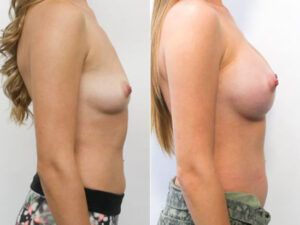
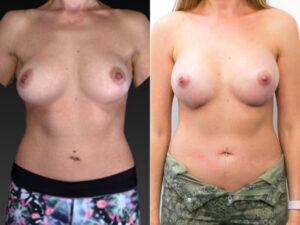

This patient desired a natural look and we were able to use Vectra 3D imaging to help her decide upon the perfect size for her goals. As you can see, the final result always looks better than the simulation but it is always helpful to have additional information so that you can make an informed decision. All patients that go through the planning process also use high tech bra inserts so you can also see when looking into a mirror wearing a surgical bra
If your desired outcome is to look quite natural, then we would tend to recommend lower profile or lower projection implants. The goal here is to add shape and volume but not in a way that dominates the silhouette in any way. The options for implants here are usually a Motiva demi or even mini profile implant or possible a mid range Mentor CPG moderate of low profile implant.
Both types of implant give an exceptionally natural result. My preference is to usually go with a Motiva ergonomix gel density as it feels very natural to the touch. The implants are almost always placed in the ‘dual plane’ position.
Hybrid breast augmentation techniques are also generally uses to achieve the natural look. Please be mindful that everyone has their own definition of natural, and so we recommend bringing in some photos you have for inspiration, so that we can be on the same page when planning.
The planning process is a collaborative one, where we will go through three to four different techniques to narrow down the correct implant to use for your augmentation.
* Watch out for ‘breast greed’ phenomenon. This occurs if you are overly conservative with your initial breast implant choice and end up loving your new implants but feeling like the result would be even better if it was just a little bigger. Let’s get it right the first time! This can happen from time to time and we usually wait 6 months before changing the size to allow the skin to soften first.
The FULL natural look
The Full Natural Look can be best thought of as somewhere between a natural look and something a little fuller.
The implants used to achieve this look are commonly between 275cc and 400cc. This is dependent on your existing breast volume and your frame.
Hybrid breast augmentation techniques can also be used here.
The Full Look
The Full Look involves breasts that are prominent with close cleavage lines as well as ‘side breast’. The breast often sits full in the upper pole and looks voluptuous all over. This look often suits women who have a curvy, fuller figure.
Implant volumes can vary widely here but are usually 400cc and above. If the goal is upper pole fullness, then the firmer gel round implants from Motiva can be helpful. These implants can look and feel more ‘fake’ than a natural breast but this is often the point as well.
Use of implant stabilising techniques such as lateral pocket support (often incorrectly called an internal bra) are mandatory and the larger implants may even benefit from the use of Tiloop pockets which are a soft, biologically compatible mesh that is physically internally sewn on the inside to support the breast implant. The Tiloop pockets are expensive but can be very helpful at maximising the support within the breast of the implant.
It is also good to be realistic about what you can achieve in a single operation here as well. Unless you have loose skin after breast feeding or have had massive weight loss there is only so much volume that can fit into a breast in one operation. So if you want to be really full in volume you may need multiple operations separated by at least 6 months so we can give the breast skin a chance to soften and loosen up before the final operation.
POST BREAST FEEDING AUGMENTATION
It is normal for changes to the breast to occur following pregnancy, weightloss and gain as well as breast feeding. Usually the breast has globally lost volume and looks deflated afterwards.
If your nipple position is still above the crease of your breast then the loss of volume can essentially be fixed with a standard breast augmentation in Sydney
This particular type of augmentation is often easier to recover from, as there is already an abundance of loose skin prior to surgery. So the implant will simply fill that space up.
I would strongly suggest to wait until you have had all of your children before undertaking breast augmentation so that the result may longer. At least six months post pregnancy is best so that we can determine the ideal volume to use, as well as minimising the risk of restarting lactation inadvertently.
Autologous breast augmentation (fat grafting augmentation)
Autologous Great Augmentation is where we use your own tissue to augment your breast. A breast is composed of breast glands and breast fat. We can usually harvest fat from ‘donor site areas’ on your body and repurpose and reuse that fat in the breast.
Not everyone qualifies for this operation for a number of reasons. Firstly, most patients who desire an increase in breast volume tend to have quite slender frames in the first place- there simply isn’t enough fat to take to make a decent breast. Secondly, fat is a biological meaning that fat graft take rates can only be expected to be about 2/3 and this can vary from left to right side because of the unpredictability of fat graft take. Thirdly, sometimes breasts need shape pushed into them, and fat only tends to add volume to your existing shape whereas an implant can really make your breast take an improved shape.
Mathematically, most decent fat grafting augmentations would need almost 750cc of fat to give a modest result. The time for the operation is also often much longer because of the liposuction required to provide enough fat.
Possible donor sites can include the flanks (muffin top area), the lower abdomen and thighs. I almost aways use fat with every breast augmentation procedure but only in small volumes to finesse the result with an implant, and rarely use fat alone.
Asian patient with augmentation
There are specific considerations when performing augmentations on Asian patients. Firstly, the skin thickness is often quite thick which is relevant in two ways. Firstly the skin is often particularly good at supporting the weight of the implant over time, and therefore will produce longer lasting results. Secondly, because the skin is so thick it can take a little longer for the skin to relax around the implant in a process that is called the drop and fluff phenomenon. When the skin is no longer as shiny as it was just after the augmentation then you know you have reached your final result.
Asian skin ages particularly well but the skin can be more prone to pigmentation over time. That is why we prefer to use smaller scars under the breast so that they are hidden and not visible around the nipple or armpit regions.
Finally, for those who have finished breast feeding, nipple reduction can also be helpful so that they are less prominent in clothing and underwear. This tiny modification can make a big difference so that the nipple height and volume closely match the new augmented breast.
Body building patients
Body building patients offer unique challenges to the process of breast augmentation in Sydney. There are two very important decisions that need to be made when planning your augmentation. Both have strengths and weaknesses and ultimately there will be some trade-offs.
The first and most important issue is related to the position of the implant. For most women this is commonly placed in what is called a dual plane position or ‘under the muscle’. It is placed there so that when you are standing upright, the visible part of the breast that is seen in bras and swim wear/ dresses are partially covered by your pectoralis major muscle so that it does not ripple.
This is not a huge issue for most, but when competing you may experience animation deformity when you activate this muscle. If we place the implant ‘above the muscle’ then this won’t impact the muscle but can get significantly ripply, particularly if you use a softer gel or when you are lean for competition.
The second issue is related to the gel density. It often makes sense to use a firmer gel here to minimise the amount of rippling. However you may end up with a firmer and arguably ‘faker’ look when using a firmer implant compared to the standard density gel (ergonomix). A consultation with Dr Alex Phoon will help you to figure out what is the best fit for you.
Tuberous Breast correction surgery
Tuberous breast deformity is a congenital condition and often features;
- Breast asymmetry
- Wide breast gap spacing
- Puffy nipples where breast tissue often almost bulges through
- High breast crease with a short distance from the nipple to the bottom of the crease under the breast.
It is common for women to have one or two of the tuberous breast elements without being thought of as having the full spectrum deformity. If you have some of these elements then a breast augmentation surgery with fat grafting is usually enough to get you the ideal result. If you have the full spectrum of the condition then you will often require a staged approach, sometimes with a lift, tissue expansion and almost definitely fat grafting.
Total tuberous breast correction is one of the more difficult areas of breast augmentation surgery and can be considered as much aesthetic as reconstructive. As such, it is one of a few instances with augmentation surgery where Medicare and the insurance funds do offer some support.
Transgender Augmentation
Breast augmentation surgery for transgender patients generally presents with additional considerations. Transgender patients usually have thicker skin and sometimes more developed pectoralis muscles which can present certain challenges.
Whilst hormonal therapy can sometimes lead to breast development, it often mimics elements of the tuberous breast deformity with asymmetry and large gaping between the breasts. When faced with these challenges, we often need to push some shape into the breast with a high profile or at least moderate profile implant to make the thicker skin conform to the implant. The positioning of the implant, relative to the muscle, is also relevant with most benefiting from an under the muscle approach.
It can take a little longer to reach the desired outcome as the intrinsic thickness of the skin does tend to take longer to relax around the new implant. There are also usually upper limits with volumes that can be achieved in one stage. Should your goals be a fuller look then a staged approach can sometimes be indicated.
FREQUENTLY ASKED QUESTIONS ABOUT OUR BREAST AUGMENTATION SURGERY
You will probably feel tired and sore for several days after the breast augmentation surgery, so rest is essential. It’s normal to experience a feeling of tightness in the breast area as your skin adjusts to your new breast size and your breast implants. You may also notice diminished feeling in your breasts and nipples during immediate recovery.
Your surgeon will ask you to wear a postoperative bra and/or compression bandage for extra support and positioning while you heal. Most patients are able to return to work after one week. It’s best to avoid any strenuous activities that could raise your pulse and blood pressure, or which require strenuous use of your arms and chest.
Your surgeon will be able to provide you with more specific details about the recovery process.
Your breast augmentation surgery is performed on an outpatient basis, in a hospital operating room. The surgery will always be performed under full general anesthetic.
Choosing an implant size is an important personal decision that you will make during your consultation . I will help to guide you through the process of deciding which size will be best to achieve the look you desire, as well as which size will best suit your body and lifestyle.
Choosing the right size breast implant is one of the most important decisions in the breast augmentation process. I will take the time to help you make the best decision based on your anatomy and the aesthetic appearance you wish to achieve. I will take the time to listen and understand your goals, take measurements and guide you through trying on different sized implants.
Every patient is unique and has different aesthetic goals they wish to achieve by having a breast augmentation procedure.
The scar tissue or capsule that normally forms around the implant may tighten and squeeze the implant and is called capsular contracture. Capsular contracture is more common following infection, hematoma, and seroma. It is also more common with sub-glandular placement. Symptoms range from firmness and mild discomfort, to pain, distortion, palpability of the implant, and/ or displacement of the implant. Additional surgery is needed in cases where pain and/or firmness is severe. This surgery ranges from removal of the implant capsule tissue to removal and possibly replacement of the implant itself.
Many women with breast implants successfully breastfeed their babies. Some breastfeeding difficulties have been reported following breast surgery particularly when a surgeon uses a periareolar (around the nipple) incision. It is important that you let your surgeon know if you are planning or considering getting pregnant after your surgery.
Feeling in the nipple and breast can increase or decrease after implant surgery. The range of changes varies from intense sensitivity to no feeling in the nipple or breast following surgery.
Like any other surgical procedure, breast augmentation is a medical procedure. The surgery is performed under a general anesthetic, so you won’t feel anything during surgery. Patients may experience some discomfort during the first five days of recovery. You will be discharged from hospital with prescriptions for the appropriate pain management medication. If you are concerned about any form of pain that might be associated with your potential procedure, it is best to raise these concerns with me during the consultation. My team are available to support you during your recovery.
You should be close to your ideal weight. A significant loss of weight after having a breast augmentation could affect your results and the aesthetic outcome. There could be some ptosis (drooping) and a reduction in size. A significant gain in weight could cause an increase in breast size.
Silicone gel-filled breast implants have undergone changes over time to meet increasingly sophisticated consumer expectations. The first silicone breast implants used thick shells and contained firm gel. The second generation of implants (introduced in the late 1970’s) had thinner shells and used less firm gel to address the concerns of patients and surgeons who believed that implants were too firm, palpable, and visible.
In the mid-1980s, concerns related to rupture rates of the second generation of thinner-shelled implants led manufacturers to introduce the third generation of implants. The shell and gel of these implants are slightly thicker but still soft.
Today these third-generation silicone gel-filled breast implants are typically referred to as cohesive gel implants. The implants I use have kept pace with the ever-evolving expectations of surgeons and patients who desire a safe, soft gel to retain the feel that resembles actual breast tissues.
Breast augmentation is a lifetime commitment. It is important that you are making the right choice for yourself and understand all the implications of the surgery you are considering. As per AHPRA guidelines, there is a mandatory cooling off period of 7 days minimum, after you give consent and before you have surgery.
Breast augmentation is not an urgent procedure. If you are put under pressure to proceed with surgery right away, you should walk away and look elsewhere.
The cost of breast implants surgery or Breast Augmentation is approximately $12,000 and is inclusive of:
All surgical care, surgeon’s fee, private hospital fees, anesthetist fees for general anesthetic, assistant surgeon fees, breast implants, surgical post-operative bra, and post-op nursing aftercare. Should you have major asymmetry or require additional procedures, such as fat grafting, this might mean additional costs over and above our standard fee.
Cosmetic breast augmentation is not covered by private health insurance and is considered a purely cosmetic operation. Private health insurance can assist in reconstructive breast augmentation to treat developmental breast abnormalities. My team of patient coordinators for cosmetic surgery will be able to provide you with further information following your consultation.
Recovery post-operatively can be thought of in two ways. Your aesthetic recovery can be seen no earlier than around 6 weeks for most patients but the final result where the breast is fully relaxed around the implant can take around 6 months. Your functional recovery is the hardest in the first week after surgery. You’ll feel tight and there will be swelling and bruising. You’ll be wearing a surgical bra for a total of 6 weeks to support your breasts. Most people will try to take a week off work and then go back to work after that. Of course, meticulous dissection, pocket creation, and a bloodless surgical field help you to return to activity faster and minimise the risks of capsular contracture. Drains are no longer used for primary breast augmentation. The whole procedure takes under one hour and there are dissolvable sutures and a waterproof dressing used that does not need to be changed for 10 days. You can shower anytime after surgery. The post-surgical bra is included in your surgical fee and needs to be worn for 6 weeks after surgery to allow the implant to heal in the correct location. Most patients can return to work in under a week and also drive at that point. We advise patients not to go to the gym for upper bodywork for a full 6 weeks, but stationary bike or walking is okay.
I have extensive experience in breast reconstruction for various conditions such as:
- Tuberous breast deformity
- Major breast asymmetry
- Developmental breast abnormalities
- Pectus carinatum “Pigeon chest” deformity
- Pectus excavatum “Hollow chest” deformity
When the appearance of your breasts affects you; you may wish to do something about it. Why? The reasons may range from self- all the way to practical concerns of being able to buy bras without difficulty. The first question that needs to be answered is this: What is the goal? Once we establish this, then it is a carefully planned process using surgical techniques that we work through together to achieve your goals.
The scar can be anywhere between 3-5cm long and hidden in the crease under your breast. The incision is placed here for several important reasons. Firstly, the best scars are always placed increases- and the crease under your breast is one of the best ones. Secondly, we minimise long-term scarring around the implant when we avoid areas that have bacterial contamination such as the nipple and the armpit. Look at the gallery and you will find it almost impossible to see any of our scars.
Every breast augmentation has specific internal sutures that help to support the breast and implant over time. That does not mean that you never need to wear a bra again, however! Technically speaking, there is only one actual internal bra solution using a titanium-impregnated mesh material, but it is only used in the very rarest of scenarios.
Hybrid breast augmentation refers to the use of the latest-generation breast implant in addition to some fat grafting to finesse the final result. You can think of it as the ultimate two-for-one surgical procedure as you can have liposuction to a stubborn area and use that fat to pad or soften areas of the breast you may be deficient in. Common areas where this is helpful are the cleavage areas and under the breast, if you have a tuberous variation. You can expect 2/3 of the fat to remain in the long term!
Most patients will have the implant placed behind the muscle in what is called a customized dual-plane position. This means that the top of the implant is overlapped by the pectoralis muscle to help with coverage in a thin patient. This is not always the case, and in patients that have good breast coverage or are bodybuilders, the implant will be placed above the muscle (but behind the breast). Both approaches work well and the decision regarding what is best for you will be determined after your examination with Dr Phoon.
I have a huge experience with Mentor anatomical implants and will still use them for a few indications. Although anatomical implants are fantastic (and have not been recalled) they are not without their drawbacks. The implants can rotate on the chest wall, they can also ripple when you are thin, and they have the lowest risk of all the microtextured implants available of 1/80000. Studies have repeatedly shown that it is almost impossible to tell the difference between round and anatomical implants that are less than 350cc in size- which accounts for most implants used today.
For that reason, I will mostly use a Motiva round implant that has specific gel characteristics that make it mimic an anatomical implant whilst also giving more upper pole fullness and a softer feel.
We use Motiva Breast Implants. Motiva Implants are designed with patient safety as the top priority, Motiva implants not only look good but also feel great.
We offer two different types of Motiva Implants;
Motiva Ergonomix
Designed for women who want a breast implant that offers the most natural look and feel possible; one that even adapts to their natural movements.
Motiva Round
This is a round implant filled for firmness without compromising softness. It is designed to provide the highest projection, balanced firmness, and a complete filling of the upper pole of the breast.
Risks and complications of cosmetic surgery
Cosmetic surgery is still surgery and as such always has potential risks and complication. It is important for anyone considering cosmetic surgery to be well-informed and aware of the possible adverse outcomes. Dr Alex Phoon is a fully qualified Australian specialist plastic and cosmetic surgeon who operates with an experienced team in leading public and private hospitals in Sydney Australia.
In this article, we will dive into the various risks and complications associated with cosmetic surgery, providing insights into each aspect.
Scarring
One of the most common concerns among patients undergoing cosmetic surgery is the potential for scarring. While skilled surgeons strive to minimize scarring, it is an inevitable part of the healing process.
Read moreThe severity of scarring varies depending on the individual and the procedure performed. Certain factors, such as genetics and skin type, can also influence how prominent scars may be. However, it is worth noting that in many cases, scars fade over time and can be further improved through scar revision techniques.
Scarring is a natural part of the body’s healing process. When the skin is injured, whether through surgery or trauma, the body responds by forming new collagen fibres to repair the damage. This process can result in the formation of a scar, which is a visible mark on the skin that differs in texture and colour from the surrounding tissue.
There are different types of scars that can occur after cosmetic surgery. One common type is a hypertrophic scar, which is characterized by raised and thickened tissue. These scars may be red or pink in colour and can be itchy or uncomfortable. Another type of scar is a keloid, which is an overgrowth of scar tissue that extends beyond the boundaries of the original wound. Keloids are more common in individuals with darker skin tones and can be more challenging to treat.
Fortunately, advancements in surgical techniques and post-operative care have greatly improved the management of scars. Surgeons take great care in placing incisions in inconspicuous areas and using techniques to minimize tension on the wound, which can help reduce the risk of visible scarring. Additionally, patients are often advised to follow a specific scar care regimen, which may include keeping the incision site clean, applying silicone gel or sheets, and avoiding sun exposure.
In some cases, scar revision techniques may be recommended to further improve the appearance of scars. These techniques can include laser resurfacing, dermabrasion, or surgical excision. Laser resurfacing uses a laser to remove the top layers of the skin, promoting the growth of new, healthier skin cells. Dermabrasion involves using a rotating brush or diamond wheel to gently remove the outer layers of the skin, revealing smoother skin underneath. Surgical excision involves removing the scar tissue and rejoining the edges of the skin to create a more aesthetically pleasing scar.
It is important for patients to have realistic expectations when it comes to scarring. While surgeons strive to minimize scarring, it is impossible to eliminate it. However, with proper care and the use of scar revision techniques, the appearance of scars can be significantly improved. Patients should discuss their concerns and expectations with their surgeon prior to undergoing any cosmetic procedure to ensure they have a clear understanding of the potential for scarring and the available treatment options.
Infection
Infections are another risk associated with any surgical procedure, including cosmetic surgery. Despite stringent sterilization protocols followed by healthcare professionals, there is still a possibility of infection.
Read moreTo mitigate this risk, surgeons prescribe antibiotics pre- and post-surgery, adhere to aseptic techniques, and closely monitor patients for signs of infection. It is crucial for patients to follow their surgeon’s aftercare instructions to minimize the risk of infection.
When it comes to cosmetic surgery, infection is a concern that cannot be ignored. Surgical procedures, no matter how minor, create an entry point for bacteria and other microorganisms. Although healthcare professionals take every precaution to maintain a sterile environment, the human body is naturally teeming with bacteria, making it impossible to eliminate the risk entirely.
Fortunately, surgeons are aware of this risk and take proactive measures to minimize the chances of infection. One such measure is the prescription of antibiotics. Prior to surgery, patients are often given a course of antibiotics to help prevent any potential infection from taking hold. These antibiotics are carefully chosen based on the patient’s medical history and the specific procedure being performed.
Post-surgery, patients are usually required to continue taking antibiotics for a certain period. This helps to ensure that any bacteria that may have entered the body during the procedure are promptly eradicated. By adhering to the prescribed antibiotic regimen, patients can significantly reduce the risk of developing an infection.
In addition to antibiotics, surgeons also follow strict aseptic techniques during the surgical procedure itself. This involves maintaining a sterile environment, using sterile instruments and equipment, and wearing appropriate protective clothing, such as gloves and masks. These precautions help to minimize the introduction of bacteria into the surgical site, further reducing the risk of infection.
Despite these measures, it is important to note that infections can still occur. The human body is a complex system, and sometimes even the most stringent precautions cannot completely eliminate the risk. However, by closely monitoring patients for signs of infection, surgeons can detect and treat any potential infections early on, preventing them from becoming serious complications.
Patients also play a crucial role in minimizing the risk of infection. Following the surgeon’s aftercare instructions is of utmost importance. This may include keeping the surgical site clean and dry, avoiding certain activities or behaviours that could increase the risk of infection, and promptly reporting any signs of infection, such as redness, swelling, or discharge.
In conclusion, while the risk of infection is present in any surgical procedure, including cosmetic surgery, healthcare professionals take numerous precautions to minimize this risk. From prescribing antibiotics to following aseptic techniques, surgeons prioritize patient safety and strive to create the best possible outcome. However, it is essential for patients to actively participate in their own aftercare and follow the instructions provided by their surgeon to further reduce the risk of infection.
Pain
Pain and discomfort is a common experience following cosmetic surgery but can be mitigated with modern analgesic strategies.
Read moreThe extent of pain can vary depending on the procedure, the individual’s pain tolerance, and the body’s healing response. Surgeons typically prescribe pain medications to manage any discomfort during the recovery period. It is important for patients to communicate their pain levels with their healthcare providers, as proper pain management is crucial for a smooth recovery.
Undesirable cosmetic outcome
While cosmetic surgery aims to enhance aesthetics, there is always a risk of an undesirable cosmetic outcome.
Read moreFactors such as unrealistic expectations and the biological unpredictability of healing can contribute to suboptimal results. It is essential for patients to have open and honest discussions with their surgeons about their desired outcomes, potential limitations, and realistic expectations. This helps ensure that both parties are on the same page and reduces the chances of disappointment. Revision surgery might be an option should this be an issue.
Nerve damage
Another potential complication of cosmetic surgery is nerve damage.
Read moreSurgeons take great care to avoid damaging nerves during procedures, but it is not always possible to eliminate this risk entirely. Nerve damage can cause numbness, tingling, or loss of sensation in the operated area. In most cases, nerve function gradually improves, but it may take some time for complete resolution. Patients should be aware of this potential risk and discuss it with their surgeon before proceeding with the surgery.
Bruising and swelling
Bruising and swelling are common after cosmetic surgery, particularly in the early stages of recovery.
Read moreThese symptoms are part of the body’s natural response to trauma. Surgeons may recommend compression garments, elevation, and cold compresses to help minimize these effects. While bruising and swelling are temporary, they can cause discomfort and can affect the recovery timeline. Patience and adherence to post-operative guidelines can aid in reducing the duration and severity of these side effects.
Bleeding
Bleeding during or after surgery is a potential complication that can occur in any surgical procedure, including cosmetic surgery.
Read moreSurgeons take measures to control bleeding during the operation, but occasionally, some post-operative bleeding may occur. It is crucial for patients to inform their healthcare providers if they experience excessive bleeding or if they are unable to control bleeding with gentle pressure. Immediate medical attention is necessary to address this complication. If there is major bleeding, you might require a blood transfer or transfer to a hospital for additional treatment.
Seroma
A seroma is a pocket of fluid that can accumulate under the skin after surgery.
Read moreIt forms as a result of the body’s inflammatory response. Seromas are more common in larger surgical procedures and can lead to swelling and discomfort. Surgeons may drain seromas through aspiration or place drains to prevent their accumulation. A surgical drain can be used to minimise this risk. Close monitoring by healthcare providers is crucial to ensure the timely detection and management of seromas.
Anaesthetic complications
Although rare, complications related to anaesthesia can occur during cosmetic surgery.
Read moreAnaesthesia is administered to ensure patient comfort and safety during the procedure. Factors such as individual reactions, allergies, or underlying health conditions can increase the risk of complications. Anaesthetists are highly trained professionals who monitor patients closely throughout the surgery to minimize any potential risks.
Death
While the risk of death from cosmetic surgery is extremely low, it is essential to acknowledge that any surgical procedure carries inherent risks.
Read moreEvery effort is made to prioritize patient safety and ensure favourable outcomes. The preoperative assessment, careful surgical planning, and adherence to appropriate protocols help minimize this risk. Patients should discuss their specific concerns with their surgical team and feel confident in the expertise and experience of their chosen surgeon.
In conclusion, cosmetic surgery offers individuals an opportunity to enhance their appearance, but it is essential to recognize that it is not without its risks and complications. By understanding and discussing these potential outcomes with their surgeons, patients can make informed decisions and take necessary precautions to optimize their safety and overall surgical experience. With proper expectations, diligent aftercare, and open communication, the risks associated with cosmetic surgery can be minimized, and the goal of achieving desired aesthetic improvements can be realized.





